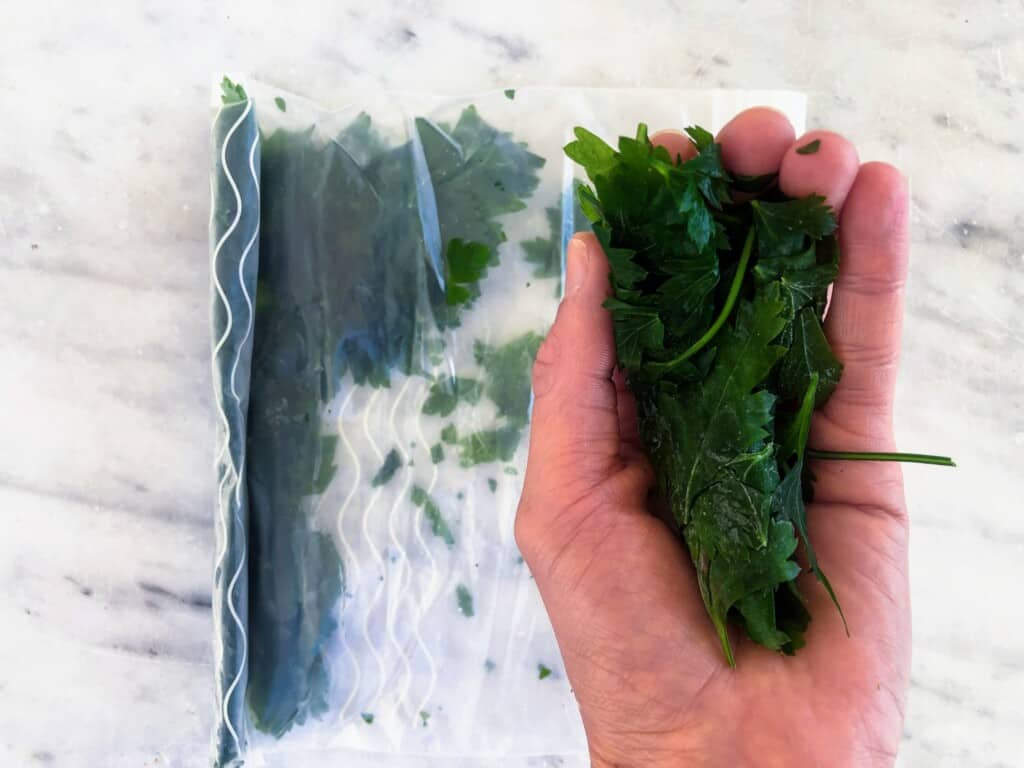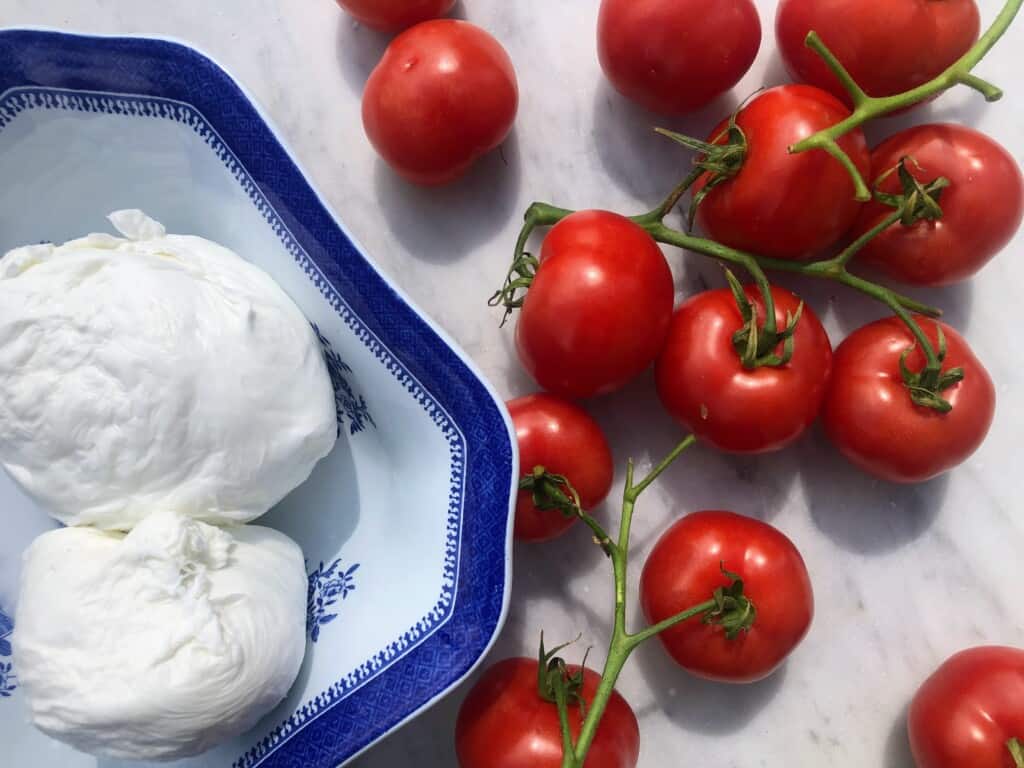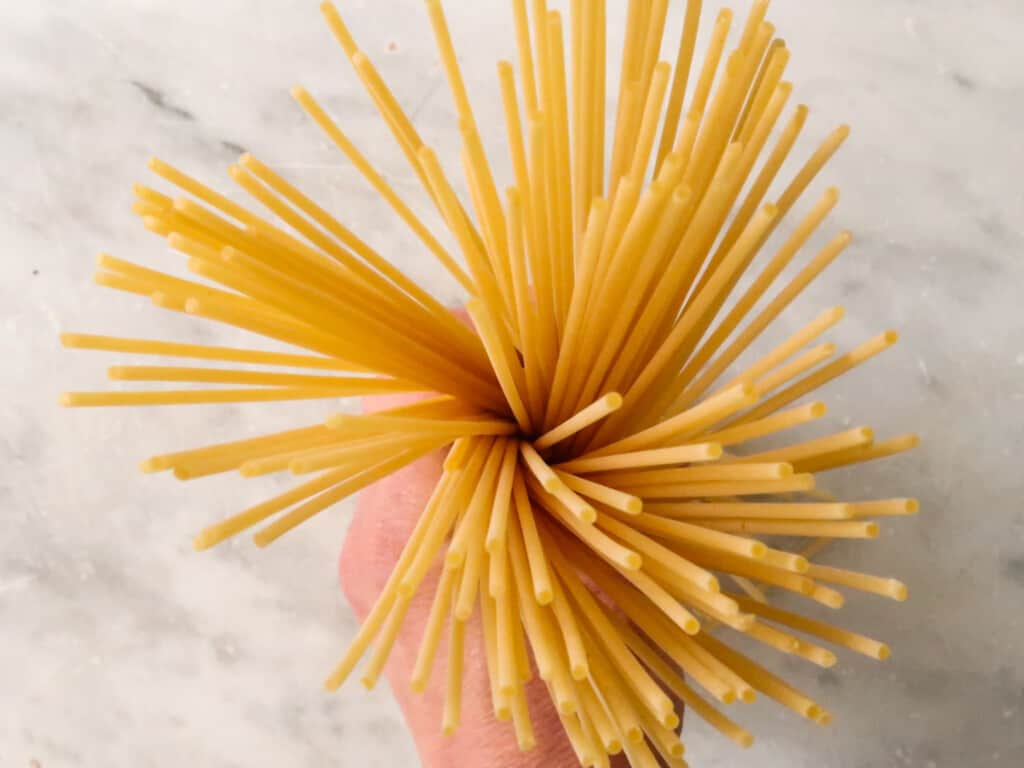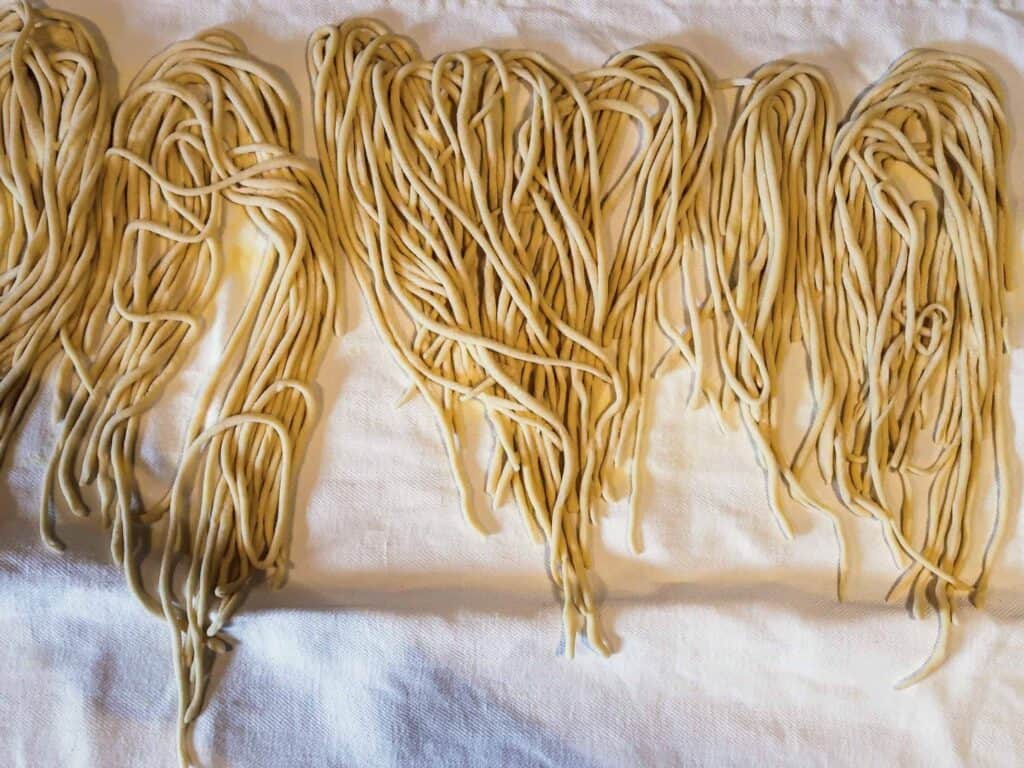Last updated on April 4th, 2024
Are you looking to preserve your fresh parsley so you can brighten up your cooking even in the dead of winter?
Freezing parsley is not only quick and easy but it’s also a great way to give a boost of summer, fresh flavor to slow cooked meals.
Brighten up any number of hearty stews, soups, or simply add to roasted vegetables by adding just a touch of frozen parsley. Be forewarned that freezing parsley changes the texture considerably so it’s best used when you will be actually cooking it.
In this article, I will show you how to freeze parsley using various methods, how to defrost and use it in the kitchen and share all my tips and tricks for adding it to recipes.
Jump to Section
How To Say Parsley In Italian
Parsley in Italian is prezzemolo, pronounced prehz-zeh-moh-loh.
Listen to the pronunciation of parsley here:
Curly Versus Flat-Leaf Parsley

If you are given the choice between curly and flat-leaf parsley (sometimes called Italian parsley), always opt for flat-leaf because it’s much more flavorful and has a smoother texture.
Curly parsley is a bit bland and has a rough, uneven texture that isn’t very nice to bite down on. Flat-leaf parsley, on the other hand, has smooth, wide leaves that are not only beautiful, and easy to clean but also have a level and even texture, perfect for eating whole.
In addition, curly parsley can be a bit tough to separate from the stems as it has more of a structured, woody composition.
Why Freeze Fresh Parsley Leaves
- preserve the nutritional value of parsley by freezing it (compared to other ways of storage)
- extend shelf life and use fresh parsley year round.
- helps to reduce food waste by storing what cannot be used within a week’s time.
- it’s a no-brainer: super easy to do and takes almost no time whatsoever.
- preserve fresh, summer flavor for cold, winter months when fresh parsley is out of season
Chopping And Mincing Fresh Parsley

Chopping Fresh Parsley
After thoroughly washing your parsley, remove the leaves from the stems and ball them together into a small, compact pile. While holding the pile tight with one hand, use a sharp knife to thinly slice through the leaves.
Mincing Fresh Parsley
To mince fresh parsley, simply re-cut the chopped parsley as indicated above. It’s best to use a large kitchen knife and use the tip as a pivot to quickly bring the knife up and down on the parsley. Hold the knife with one hand and apply pressure to the top of the knife with the palm of your other hand from above. This allows you to quickly move the handle up and down in various directions, ensuring a fine mince.
Tip: Many Italians prefer to use a mezzaluna, a type of chopping knife meant precisely to recreate this pivot knife scenario to mince just about anything.
Freeze Fresh Parsley Leaves
Always wash and dry your parsley leaves before bagging them. The most important step to freezing parsley well is to remove as much liquid as possible to avoid freezer burn. To do so, I have had the best results with a salad spinner.
Rinse and spin the parsley thoroughly until it’s dry as possible. If you don’t have a salad spinner, place the parsley leaves on a kitchen towel and pat dry, being careful not to squeeze the parsley leaves.
Once the parsley leaves are dry, you can decide to freeze them as is or chop or mince them.
Good To Know: Freezing any fresh herb can be done using these methods. Don’t stop with parsley. Try basil, rosemary, thyme and oregano!
Freeze Parsley in a Bag

Remove the parsley from the stalks and place the clean, dry parsley leaves in a freezer ziplock bag. Create a flat layer in the bag and roll, pressing out as much air as possible without squishing or damaging the leaves. Seal the bag. Secure with a rubber band and bag again.

To use your frozen parsley, simply break off a chunk. Be sure to re-roll the log and return the unused portion to the freezer before it has a chance to defrost.
Time Saving Tip: If you are pressed for time, you can also freeze the whole parsley bunch, even with the stalks. You can then use what you like when you defrost it but it’s good to know that parsley stalks are edible too!
If you want to chop or mince the parsley before freezing, you certainly can. I find it’s harder to take out what I need if it’s already minced. I prefer freezing whole leaves and just breaking/snapping off what I need and then chopping it, if need be.
Allow the parsley to defrost on a plate or add them directly into your recipes.
Tip: To reduce chances of freezer burn, always double bag your parsley.
Freeze Parsley In Olive Oil Cubes
Best For: popping into soups and stews.

Remove the parsley leaves from the stems and place them in a food processor or blender. Add just a tablespoon of olive oil at a time until a thick paste forms. Help this process out by scraping the sides of the bowl down from time to time with a spatula.

Spoon the parsley olive oil into ice cube trays and freeze. Once frozen, transfer the parsley cubes to a freezer ziplock bag and remove as needed for up to six months.
Freeze Parsley In Water
This method is not my preferred but it does work. Chop or mince the parsley, add it directly to ice cube trays and cover with water.
Place the ice cube tray into the freezer and once completely frozen, transfer the parsley water ice cubes to a freezer ziplock bag and remove as needed for up to six months.
How To Defrost Frozen Parsley

No matter the method you have chosen to freeze fresh parsley, the method to defrost it will be the same. Take out whatever you need and place it on a covered plate (or bowl for olive oil parsley cubes) at room temperature. You can also do this in the refrigerator.
If you are cooking the parsley, there is no need to necessarily defrost it before use. Add the frozen parsley olive oil or leaves directly to the pop and let the heat do the defrosting for you.
How To Use Frozen Parsley

Because freezing fresh parsley changes its texture considerably, it’s best to stay away from summer salads using parsley or dishes in which fresh parsley leaves are used for the final presentation.
Frozen parsley is wonderful in soups, stews and meats that have been slow cooked. Add them just at the end of cooking for an earthy yet fresh boost of parsley flavor.
Popular recipes with parsley:
- beans
- peas
- chicken cacciatore
- salad dressings
- salsa verde (including Tuscan salsa verde)
- lentil soup
- lentil salad
Good To Know: Frozen parsley is best used in dishes, rather than as a garnish.
How to Freeze Parsley – Three Methods
Ingredients
- Parsley
- Extra virgin olive oil
Instructions
Method #1: In Freezer Bag
- Wash parsley well and dry well either in a salad spinner or by patting it dry with a towel. Be sure all the moisture has been removed to prevent freezer burn.
- Remove the large parsley stems
- Chop finely
- Place parsley in a freezer bag, pressing out the excess air from the bag as much as possible without smashing the parsley. Seal well.
- Lay the bag flat and freeze for up to six months.
Method #2: In Olive Oil
- Wash parsley well and dry well either in a salad spinner or by patting it dry with a towel. Be sure all the moisture has been removed to prevent freezer burn.
- Remove the large parsley stems
- Fill ice cube trays with the chopped parsley.
- Add extra virgin olive oil to ice cube trays, being sure to cover the parsley completely.
- Put in the freezer until completely frozen solid.
- Pop out the parsley ice cubes and transfer into freezer bags.
- Store for up to three months and take out whenever needed. Store leftover cubes in the freezer.
Method #3: In Water
- Wash parsley well and dry well either in a salad spinner or by patting it dry with a towel. Be sure all the moisture has been removed to prevent freezer burn.
- Remove the large parsley stems.
- Fill ice cube trays with the chopped parsley.
- Add water to ice cube trays, being sure to cover the parsley completely.
- Put in the freezer until completely frozen solid.
- Pop out the parsley ice cubes and transfer into freezer bags.
- Store for up to three months and take out whenever needed. Store leftover cubes in the freezer.
How To Freeze Parsley FAQ
Refreezing parsley is not the best idea. Bacteria can get trapped between freezings and the flavor is greatly impacted when handled this much.
Parsley does freeze very well in terms of flavor. It does, however, lose its beautiful leafy appearance so it’s best used in cooked dishes, rather than as a garnish.
Yes, you can and it works very well. Follow the guidelines above for freezing parsley in olive oil or water and add whatever other herbs you like to the mix.
Yes, you should always clean and dry your parsley well before freezing because the dirt is hard to remove later and the excess moisture can create freezer burn.
If you have the freezer space, freezing it is a much better option because the flavor and aroma remains much more potent.
Yes, you can absolutely use the stems because they are 100% edible. The leaves are much more tender and sweet than the stems but don’t worry if they end up on your chopping board.




